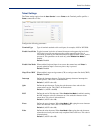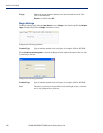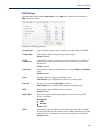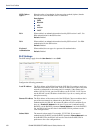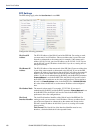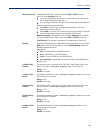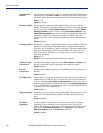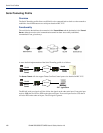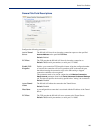
157
Serial Port Profiles
IPv6 Remote
Interface Identifier
The remote IPv6 interface identifier of the remote end of the PPP link. Choose
an address that is part of the same network or subnetwork as the IOLAN. If
you enable
Negotiate IP Address Automatically, the IOLAN will ignore the
remote IP address value you enter here and will allow the remote end to
specify its IP address. If your user is authenticated by RADIUS and the
RADIUS parameter
Framed-Interface-ID is set in the RADIUS file, the
IOLAN will use the value in the RADIUS file in preference to the value
configured here.
Field Format: The first 64 bits of the Interface Identifier must be zero,
therefore, ::abcd:abcd:abcd:abcd is the expected format.
ACCM Specifies the ACCM (Asynchronous Control Character Map) characters that
should be escaped from the data stream.
Field Format: This is entered as a 32-bit hexadecimal number with each bit
specifying whether or not the corresponding character should be escaped. The
bits are specified as the most significant bit first and are numbered 31-0. Thus
if bit 17 is set, the 17th character should be escaped, that is, 0x11 (XON). The
value 000a0000 will cause the control characters 0x11 (XON) and 0x13
(XOFF) to be escaped on the link, thus allowing the use of XON/XOFF
(software) flow control. If you have selected
Soft Flow Control on the Serial
Port, you must enter a value of at least 000a0000 for the ACCM.
Default: 00000000, which means no characters will be escaped
MRU The Maximum Receive Unit (MRU) parameter specifies the maximum size of
PPP packets that the IOLAN’s port will accept. If your user is authenticated by
the IOLAN, the
MRU value will be overridden if you have set a MTU value for
the user. If your user is authenticated by RADIUS and the RADIUS parameter
Framed-MTU is set in the RADIUS file, the IOLAN will use the value in the
RADIUS file in preference to the value configured here.
Range: 64-1500 bytes
Default: 1500
Authentication The type of authentication that will be done on the link. You can use PAP or
CHAP to authenticate a serial port or user on the IOLAN, from a remote
location, or authenticate a remote client/device, from the IOLAN.
When setting either
PAP and CHAP, make sure the IOLAN and the remote
client/device have the same setting. For example, if the IOLAN is set to PAP,
but the remote end is set to
CHAP, the connection will be refused.
Data Options:
z None
z PAP—is a one time challenge of a client/device requiring that it respond
with a valid username and password. A timer operates during which
successful authentication must take place. If the timer expires before the
remote end has been authenticated successfully, the link will be
terminated.
z CHAP—challenges a client/device at regular intervals to validate itself
with a username and a response, based on a hash of the secret (password).
A timer operates during which successful authentication must take place.
If the timer expires before the remote end has been authenticated
successfully, the link will be terminated.
Default: CHAP





